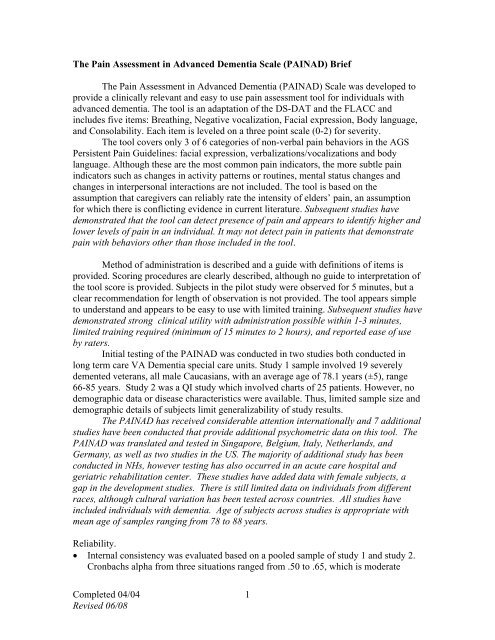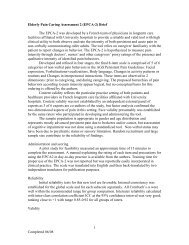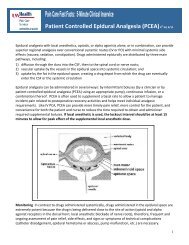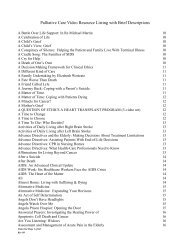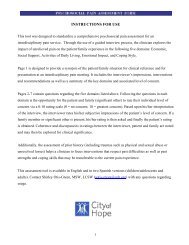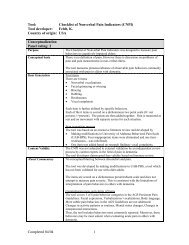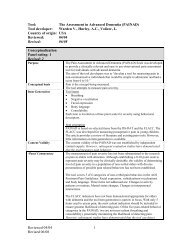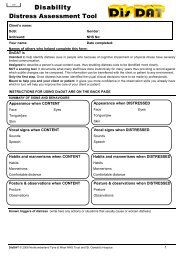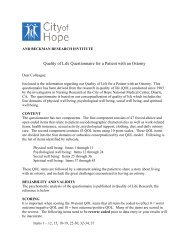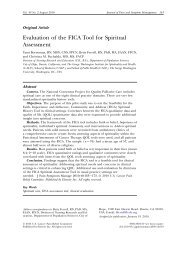The Pain Assessment in Advanced Dementia Scale (PAINAD)
The Pain Assessment in Advanced Dementia Scale (PAINAD)
The Pain Assessment in Advanced Dementia Scale (PAINAD)
- No tags were found...
You also want an ePaper? Increase the reach of your titles
YUMPU automatically turns print PDFs into web optimized ePapers that Google loves.
<strong>The</strong> <strong>Pa<strong>in</strong></strong> <strong>Assessment</strong> <strong>in</strong> <strong>Advanced</strong> <strong>Dementia</strong> <strong>Scale</strong> (<strong>PAINAD</strong>) Brief<strong>The</strong> <strong>Pa<strong>in</strong></strong> <strong>Assessment</strong> <strong>in</strong> <strong>Advanced</strong> <strong>Dementia</strong> (<strong>PAINAD</strong>) <strong>Scale</strong> was developed toprovide a cl<strong>in</strong>ically relevant and easy to use pa<strong>in</strong> assessment tool for <strong>in</strong>dividuals withadvanced dementia. <strong>The</strong> tool is an adaptation of the DS-DAT and the FLACC and<strong>in</strong>cludes five items: Breath<strong>in</strong>g, Negative vocalization, Facial expression, Body language,and Consolability. Each item is leveled on a three po<strong>in</strong>t scale (0-2) for severity.<strong>The</strong> tool covers only 3 of 6 categories of non-verbal pa<strong>in</strong> behaviors <strong>in</strong> the AGSPersistent <strong>Pa<strong>in</strong></strong> Guidel<strong>in</strong>es: facial expression, verbalizations/vocalizations and bodylanguage. Although these are the most common pa<strong>in</strong> <strong>in</strong>dicators, the more subtle pa<strong>in</strong><strong>in</strong>dicators such as changes <strong>in</strong> activity patterns or rout<strong>in</strong>es, mental status changes andchanges <strong>in</strong> <strong>in</strong>terpersonal <strong>in</strong>teractions are not <strong>in</strong>cluded. <strong>The</strong> tool is based on theassumption that caregivers can reliably rate the <strong>in</strong>tensity of elders’ pa<strong>in</strong>, an assumptionfor which there is conflict<strong>in</strong>g evidence <strong>in</strong> current literature. Subsequent studies havedemonstrated that the tool can detect presence of pa<strong>in</strong> and appears to identify higher andlower levels of pa<strong>in</strong> <strong>in</strong> an <strong>in</strong>dividual. It may not detect pa<strong>in</strong> <strong>in</strong> patients that demonstratepa<strong>in</strong> with behaviors other than those <strong>in</strong>cluded <strong>in</strong> the tool.Method of adm<strong>in</strong>istration is described and a guide with def<strong>in</strong>itions of items isprovided. Scor<strong>in</strong>g procedures are clearly described, although no guide to <strong>in</strong>terpretation ofthe tool score is provided. Subjects <strong>in</strong> the pilot study were observed for 5 m<strong>in</strong>utes, but aclear recommendation for length of observation is not provided. <strong>The</strong> tool appears simpleto understand and appears to be easy to use with limited tra<strong>in</strong><strong>in</strong>g. Subsequent studies havedemonstrated strong cl<strong>in</strong>ical utility with adm<strong>in</strong>istration possible with<strong>in</strong> 1-3 m<strong>in</strong>utes,limited tra<strong>in</strong><strong>in</strong>g required (m<strong>in</strong>imum of 15 m<strong>in</strong>utes to 2 hours), and reported ease of useby raters.Initial test<strong>in</strong>g of the <strong>PAINAD</strong> was conducted <strong>in</strong> two studies both conducted <strong>in</strong>long term care VA <strong>Dementia</strong> special care units. Study 1 sample <strong>in</strong>volved 19 severelydemented veterans, all male Caucasians, with an average age of 78.1 years (±5), range66-85 years. Study 2 was a QI study which <strong>in</strong>volved charts of 25 patients. However, nodemographic data or disease characteristics were available. Thus, limited sample size anddemographic details of subjects limit generalizability of study results.<strong>The</strong> <strong>PAINAD</strong> has received considerable attention <strong>in</strong>ternationally and 7 additionalstudies have been conducted that provide additional psychometric data on this tool. <strong>The</strong><strong>PAINAD</strong> was translated and tested <strong>in</strong> S<strong>in</strong>gapore, Belgium, Italy, Netherlands, andGermany, as well as two studies <strong>in</strong> the US. <strong>The</strong> majority of additional study has beenconducted <strong>in</strong> NHs, however test<strong>in</strong>g has also occurred <strong>in</strong> an acute care hospital andgeriatric rehabilitation center. <strong>The</strong>se studies have added data with female subjects, agap <strong>in</strong> the development studies. <strong>The</strong>re is still limited data on <strong>in</strong>dividuals from differentraces, although cultural variation has been tested across countries. All studies have<strong>in</strong>cluded <strong>in</strong>dividuals with dementia. Age of subjects across studies is appropriate withmean age of samples rang<strong>in</strong>g from 78 to 88 years.Reliability.• Internal consistency was evaluated based on a pooled sample of study 1 and study 2.Cronbachs alpha from three situations ranged from .50 to .65, which is moderateCompleted 04/04Revised 06/081
given a new tool with only 5 items. Moreover, the approach of comb<strong>in</strong><strong>in</strong>g researchand QI data to establish reliability is not methodologically sound. Follow-up studieshave demonstrated good <strong>in</strong>ternal consistency with correlations rang<strong>in</strong>g from 0.69 to0.85. However, the item of breath<strong>in</strong>g is low.• Interrater reliability is reported for 19 subjects with pairs of simultaneousobservations by two <strong>in</strong>dependent raters. Pearson’s correlation coefficient: dur<strong>in</strong>gpleasant activity: r=.97 and dur<strong>in</strong>g unpleasant activity: r=.82. Interrater reliabilityreports across 5 studies <strong>in</strong>dicate strong reliability. Pearson’s r ranges from 0.75 to0.97 with most reports over 0.80.• Test-retest reliability <strong>in</strong> three follow-up studies is strong with r’s rang<strong>in</strong>g from 0.88to 0.90.Validity• Factor structure analysis for comb<strong>in</strong>ed <strong>PAINAD</strong> data: 1 factor=50.1% variance(eigenvalue 2.51), 1 m<strong>in</strong>or factor expla<strong>in</strong>ed 20.6% (eigenvalue 1.03). Further study ofthe <strong>PAINAD</strong> provides support for construct validity. A s<strong>in</strong>gle factor was aga<strong>in</strong>isolated with greater distribution of pa<strong>in</strong>. However, the number of patients withbehaviors reflect<strong>in</strong>g the high end of the scale scor<strong>in</strong>g is still small.• <strong>PAINAD</strong> was compared to the <strong>Pa<strong>in</strong></strong> VAS, DS-DAT, Discomfort VAS. Correlationcoefficients at rest were r=.75, r=.76, r=.76, respectively. <strong>PAINAD</strong> was compared tothe <strong>Pa<strong>in</strong></strong>-VAS dur<strong>in</strong>g presumed pleasant conditions: r=.87-.95 and dur<strong>in</strong>g presumedunpleasant conditions: r=.82-.91. Further study of the <strong>PAINAD</strong> provides support forgood concurrent validity with across tool correlations rang<strong>in</strong>g from 0.65 to 095 withthe exception of comparison of the <strong>PAINAD</strong> to self report of pa<strong>in</strong> (0.30).• Discrim<strong>in</strong>ant validity of the <strong>PAINAD</strong> was established <strong>in</strong> study 1 with subjects(n=19) observed dur<strong>in</strong>g a pleasant activity, dur<strong>in</strong>g rest or time of no activity, dur<strong>in</strong>gcaregiv<strong>in</strong>g that might be unpleasant with mean scores: 1.0±1.3, 1.3±1.3 and 3.1±1.7respectively.• Us<strong>in</strong>g QI data it was demonstrated that the <strong>PAINAD</strong> was able to capture pa<strong>in</strong> andchange <strong>in</strong> pa<strong>in</strong>. Average <strong>PAINAD</strong> scores prior to prn medication (6.7±1.8) and 30m<strong>in</strong>utes after pa<strong>in</strong> medication (1.8±2.2) were significant (t 24 =9.6, p
<strong>in</strong> behavior (e.g. mental status changes, aggressive behavior, changes <strong>in</strong> activities) maystill be compromised.Although cl<strong>in</strong>icians desire to have a tool that provides a 1-10 score similar to the1-10 NRS commonly used as the gold standard <strong>in</strong> verbal patients, the soundness ofestablish<strong>in</strong>g a rat<strong>in</strong>g scale with pa<strong>in</strong> severity scor<strong>in</strong>g of behaviors has not beensubstantiated <strong>in</strong> the literature. Completed studies suggest the tool could be used to showhigher and lower levels of pa<strong>in</strong>, but there is no data to attach level of pa<strong>in</strong> severity to thenumber obta<strong>in</strong>ed with the tool.Tool reliability is good for <strong>in</strong>terrater reliability, but <strong>in</strong>ternal consistency is onlymoderate and stability has not been demonstrated. Tool has good reliability <strong>in</strong> all areas.Some conceptual and methodological issues have been identified with thedevelopment and test<strong>in</strong>g of the <strong>PAINAD</strong>. However, the positive f<strong>in</strong>d<strong>in</strong>gs <strong>in</strong> detection ofchanges <strong>in</strong> pa<strong>in</strong> behavior follow<strong>in</strong>g <strong>in</strong>tervention <strong>in</strong> the QI study reported suggestsadditional study <strong>in</strong> controlled circumstances is warranted. Follow-up studies havecont<strong>in</strong>ued to document ability to detect pa<strong>in</strong> and differentiate pa<strong>in</strong> and no pa<strong>in</strong> groups.However, further study of tool sensitivity to detect change <strong>in</strong> behavior <strong>in</strong> response totreatment is needed.Source of evidenceWarden, V., Hurley, A.C., Volicer, L. (2003). Development and psychometric evaluationof the <strong>Pa<strong>in</strong></strong> <strong>Assessment</strong> <strong>in</strong> <strong>Advanced</strong> <strong>Dementia</strong> (<strong>PAINAD</strong>) <strong>Scale</strong>. Journal of theAmerican Medical Directors, Jan/Feb, 9-15.Lane, P., Kuntupis, M., MacDonald, S., McCarthy, P., Panke, J., Warden, V., Volicer, L.(2003). A pa<strong>in</strong> assessment tool for people with advanced Alzheimer’s and otherprogressive dementias. Home Healthcare Nurse, 21(1), 32-37.Costardi, D., Rozz<strong>in</strong>i, L., Costanzi, C., Ghianda, D., Franzoni, S., Padovani, A. &Trabucchi, M. (2006). <strong>The</strong> Italian version of the pa<strong>in</strong> assessment <strong>in</strong> advanceddementia (<strong>PAINAD</strong>) scale. Archives of Gerontology and Geriatrics, 44(2), 175-180.DeWaters, T., Faut-Callahan, M., McCann, J. J., Paice, J. A., Fogg, L., Holl<strong>in</strong>ger-Smith,L., et al. (2008). Comparison of self-reported pa<strong>in</strong> and the <strong>PAINAD</strong> scale <strong>in</strong>hospitalized cognitively impaired and <strong>in</strong>tact older adults after hip fracture surgery.Orthopaedic Nurs<strong>in</strong>g / National Association of Orthopaedic Nurses, 27(1), 21-28.Hutchison, R., Tucker, W., Kim, S. & Gilder, R. (2006). Evaluation of a behavioralassessment tool for the <strong>in</strong>dividual unable to self-report pa<strong>in</strong>. American Journal ofHospice and Palliative Medic<strong>in</strong>e, 23(4), 328-331.Leong, I., Chong, M. & Gibson, S. (2006). <strong>The</strong> use of a self-reported pa<strong>in</strong> measure, anurse-reported pa<strong>in</strong> measure and the <strong>PAINAD</strong> <strong>in</strong> nurs<strong>in</strong>g home residents withmoderate and severe dementia: a validation study. Age and Age<strong>in</strong>g, 35, 252-256.Completed 04/04Revised 06/083
Schuler, M., Becker, S., Kaspar, R., Nikolaus, T., Kruse, A. & Basler, H. (2007).Psychometric properties of the German “<strong>Pa<strong>in</strong></strong> Assesssment <strong>in</strong> <strong>Advanced</strong> <strong>Dementia</strong>”(<strong>PAINAD</strong>-G) <strong>in</strong> Nurs<strong>in</strong>g Home residents. American Medical Directors Association,July, 388-395.Van Iersel, T., Timmerman, D. & Mullie, A. (2006). Introduction of a pa<strong>in</strong> scale forpalliative care patients with cognitive impairment. International Study of PalliativeNurs<strong>in</strong>g, 12(2), 54-59.Zwakhalen, S., Hamers, I. & Berger, M. (2006). <strong>The</strong> psychometric quality and cl<strong>in</strong>icalusefulness of three pa<strong>in</strong> assessment tools for elderly people with dementia. <strong>Pa<strong>in</strong></strong>,126, 210-220.Cohen-Mansfield, J. & Lipson, S. (2008). <strong>The</strong> utility of pa<strong>in</strong> assessment for analgesicuse <strong>in</strong> persons with dementia. <strong>Pa<strong>in</strong></strong>, 134(1-2), 16-23.Contact <strong>in</strong>formation:Victoria Warden, RNGRECC (182B)E. N. Rogers Memorial Veterans Hospital, 200 Spr<strong>in</strong>gs Road, Bedford, MA 01730.E-mail: Victoria.Warden@med.va.gov.This summary was completed by:K. Herr, S. Decker, K. Bjoro, University of Iowa (2004).Revised by:K. Herr, H. Bursch and B. Black, <strong>The</strong> University of Iowa (2008).Contact <strong>in</strong>formation: keela-herr@uiowa.eduCompleted 04/04Revised 06/084


